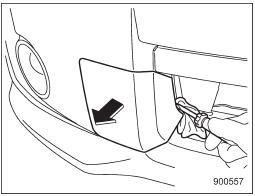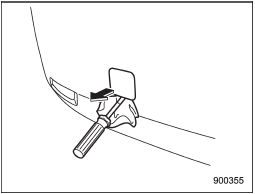Towing and tie-down hooks
The towing hooks should be used only in an emergency (e.g., to free a stuck vehicle from mud, sand or snow).

Х Use only the specified towing hook and tie-down hook. Never use suspension parts or other parts of the body for towing or tie-down purposes.
Х To prevent deformation to the front bumper and the towing hook, do not apply excessive lateral load to the towing hook.
Front towing hook (non-turbo models):
1. Take the towing hook out of the tool bucket and take the screwdriver out of the tool bag. Take the jack handle out of the trunk (4-door) or cargo area (5-door).

2. Pry off the cover on the front bumper using a screwdriver, and you will find a threaded hole for attaching the towing hook.

3. Screw the towing hook into the thread hole until its thread can no longer be seen.

4. Tighten the towing hook securely using the jack handle.
Front towing hook (turbo models):
1. Take the towing hook out of the tool bucket and take the screwdriver out of the tool bag. Take the jack handle out of the cargo area.

2. Cover the tip of a flat-head screwdriver with vinyl tape or cloth so that it will not scratch the bumper. Insert the flat-head screwdriver into the cutout of the cover and pry open the cover.

3. Screw the towing hook into the threaded hole until its threads can no longer be seen.

4. Tighten the towing hook securely using the jack handle.
After towing, remove the towing hook from the vehicle and stow it in the tool bucket.
Fit the towing hook cover on the bumper.

Х Do not use the towing hook except when towing your vehicle.
Х Be sure to remove the towing hook after towing. Leaving the towing hook mounted on the vehicle could interfere with proper operation of the SRS airbag system in a frontal collision.
Rear towing hook:
1. Take the towing hook out of the tool bucket and take the screwdriver out of the tool bag. Take the jack handle out of the trunk (4-door) or cargo area (5-door).

2. Pry off the cover on the rear bumper using a screwdriver, and you will find a threaded hole for attaching the towing hook.

3. Screw the towing hook into the thread hole until its thread can no longer be seen.

4. Tighten the towing hook securely using the jack handle.
After towing, remove the towing hook from the vehicle and stow it in the tool bucket.
Fit the towing hook cover on the bumper.

Do not use the towing hook except when towing your vehicle.
Front tie-down hooks:

The front tie-down hooks are located between each of the front tires and the front bumper.
Rear tie-down hooks:

The rear tie-down hooks are located near each of the jack-up reinforcements.

Use the rear tie-down hooks only for downward anchoring. If they are used to anchor the vehicle in any other direction, cables may slip off the hooks, possibly causing a dangerous situation.
See also:
Parking on a grade
Always block the wheels under both vehicle and trailer when parking. Apply the
parking brake. You should not park on a hill or slope. But if parking on a hill
or slope cannot be avoided, you shoul ...
Audio set
Your SUBARU may be equipped with one of the following audio sets. Refer to the pages indicated in this section for operating details.
NOTE
If a cell phone is placed near the audio set, it may cause ...
Parking brake lining
The break-in maintenance for the parking brake linings should be performed at
a SUBARU dealer. ...


